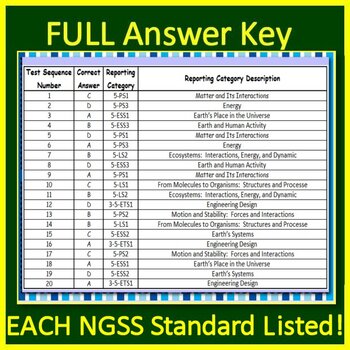5th Grade Science Test Prep Task Cards: NGSS Next Generation Science Standards
- PDF
What educators are saying
Also included in
- Next Generation Science Test Prep: This bundle has EVERYTHING you need to review the new Next Generation Science Standards. ALL NGSS standards from grades 3 - 5 are covered using a variety of learning tasks. ALL of the practice tests are written in SELF-GRADING GOOGLE FORMS. (Printable copies also iPrice $28.00Original Price $53.00Save $25.00
Description
5th Grade NGSS Science Test Prep - Improve science scores on standardized tests using these task cards for Grade 5. Includes 20 multiple choice NGSS standardized test questions and answers.
The answer key also includes each NGSS standard, so it is super easy to tally which standards are mastered, and which need extra attention.
The 20 multiple choice NGSS standardized test questions on the task cards include:
-Matter and It’s Interactions
-Motion and Stability: Forces and Interactions
-Energy
-From Molecules to Organisms: Structures and Processes
-Ecosystems: Interactions, Energy, and Dynamics
-Earth’s Place in the Universe
-Earth’s Systems
-Earth and Humanity
-Engineering Design
Next Generation Science Standards
Thank you and good luck on the test!
Why am I qualified to write these test prep questions? Not only have I worked as a teacher for 30 years with a Highly Qualified Status, but I also have spent 15 years writing state and national assessments, such as the SATs, ACTs, and individual state assessments that align with the Common-Core standards. This includes grading, item writing, and passage writing for these assessments.
Helpful for: NECAP STEP TCAP MSP WKCE PAWS CCSS PARCC, SC Ready, Smarter Balanced, SBAC, MCA, MCAS, LEAP 2025, ITBS, TerraNova, PSSA, NC EOG, NC Ready TNReady, ILEARN, Ohio’s State Test OST, Oklahoma State Test (OSTP) IAR, NJSLA, NWEA MAP, MCAP, STAAR Science Test Prep CMAS, IAR, CAASPP, MCAS, Engage NY
The 26 states involved in developing the NGSS, called Lead State Partners, were Arizona, Arkansas, California, Delaware, Georgia, Illinois, Iowa, Kansas, Kentucky, Maine, Maryland, Massachusetts, Michigan, Minnesota, Montana, New Jersey, New York, North Carolina, Ohio, Oregon, Rhode Island, South Dakota, Tennessee, Vermont, Washington, and West Virginia.






